HALF PRICE SALE ENDS AT MIDNIGHT ON FRIDAY – ORDER NOW!
***TODAY ONLY – GET AN EXTRA 10% OFF SALE PRICES WITH CODE FLASH10***
Menu
HALF PRICE SALE ENDS AT MIDNIGHT ON FRIDAY – ORDER NOW!
***TODAY ONLY – GET AN EXTRA 10% OFF SALE PRICES WITH CODE FLASH10***
You are here: Home »
Laurel hedging plants tend not to be susceptible to pests and diseases, particularly once established. Occasionally pests and diseases do occur but they are rarely serious and do not warrant intervention with chemicals or sprays, the hedge will normally recover naturally. Read our guide below to help you spot the warning signs for the most likely Laurel hedging diseases, pests and other problems.
Newly planted Laurel hedge plants (bare roots in particular but sometimes root ball plants as well) can drop some or all of their leaves after planting. This Laurel hedging problem is most common if the weather is very harsh during winter or turns very warm quickly in the spring especially when the hedge is planted late in the season – as a stress response to conserve water, the leaves will turn yellow and drop.
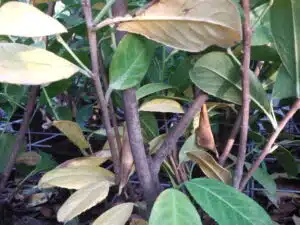
If the new plants are kept well-watered and have been planted in suitably prepared soil they should re-leaf later on – during late spring or early summer once the roots have become established. Leaf drop can be minimised by good soil preparation, sufficient watering after planting, mulching and using Rootgrow when planting as this will help the new root system to establish much more quickly.
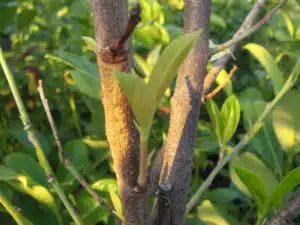
Bay Laurel and Spotted Laurel hedge plants are always pot grown and do not normally suffer from leaf drop.
Powdery Mildew
This is a fungal Laurel hedging disease that appears as a white powdery coating on the surface of the leaves. As the fungus develops, the underlying leaf tissue will turn brown and die and the young leaves can often be left with holes, brown patches and ‘tatty’ edges to them. These symptoms can make Laurel hedge plants look more like they have been attacked by pests than a disease.
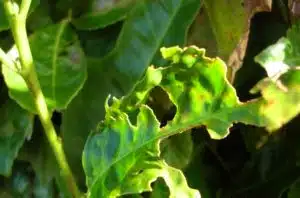
Powdery mildew can often develop due to weather conditions, while it can make your Laurel hedging plants look scrappy and unsightly, it is usually not serious and when environmental conditions change the plants will grow out of it. If you’re really concerned, however, you can trim away the affected leaves.
Shot hole is a disease that can occur on Cherry Laurel hedge plants. This can be a bacterial or fungal problem and manifests as brown spots appearing on the leaf’s surfaces – as the plant fights to bring the disease under control, the diseased spots will fall out, leaving holes in the leaves (which sometimes have yellowish halos around them).
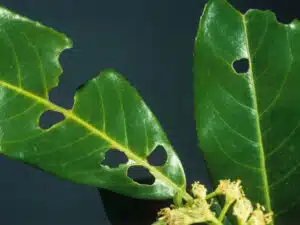
Laurels affected by bacterial shot hole often have a yellowish halo around the holes
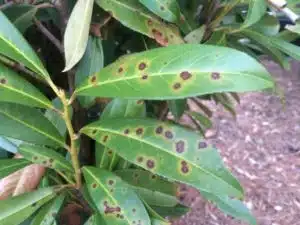
Both types of shot hole are spread by warm and wet conditions during the growing season and most commonly affect younger plants. When environmental conditions improve, and as the Laurel plants get older they will almost always recover.
If your hedge does show signs of shot hole it is worth regularly sterilising tools when trimming the hedge to limit any potential spread, also do avoid composting any affected hedge cuttings to stop a potential cycle of infection in the garden.
Here are the most likely Laurel hedge pests.
Vine Weevils: These six-legged black insects are a menace all year round – the mature weevils attack the leaves throughout summer and autumn, and the young grubs eat away at the root system through winter. Biological control such as nematodes can be used, and make sure to only use them as directed. You could also encourage natural predators like birds, nematodes, shrews and hedgehogs, which will also improve the biodiversity of your garden.
Slugs: Slugs can be a problem with younger Laurel hedging plants – use organic slug pellets to control them, or like with vine weevils, you can introduce predators that eat them to your garden – nematodes, in particular, are pest-specific and won’t kill beneficial insects in your garden.
Rabbits: Rabbits, like slugs, can do a lot of damage to younger Laurel plants. They strip the leaves off and eat them. Consider fencing off your hedging with chicken wire until it is established – once mature and a height of 3-4ft tall, it will be more difficult for rabbits to reach the leaves.
Bay Sucker: As the name suggests, Bay Suckers are a problem for Bay Laurel hedging specifically. These are sap-sucking bugs that infect Bay plants, causing the leaves to shrivel up and discolour. This damage is superficial and is unlikely to hurt the long-term health of the hedging, so control is not necessary.
The other main problem that can afflict Laurel hedging plants is frost damage, which can take effect in autumn, winter or spring.
Damage in the autumn is often caused by sharp early frosts and is limited to soft late growth, which turns black and shrivelled. It is a good idea to cut off any affected shoots back to clear healthy wood as this will prevent fungal diseases from taking hold through the frost-damaged tissue. Young Common Laurel plants are most commonly affected.
Frost damage during the winter months can cause brown patches on established Laurels of all types and is usually at its worst when there is a very cold wind with no protective cover of snow to protect the winter foliage. Affected hedging plants can look rather unsightly until a new flush of growth appears in late spring by which time the brown leaves will usually have moulted.
Frost damage in the spring almost always affects the soft vulnerable new growth as it emerges. The affected shoots will wither and turn black very quickly, while this can look unsightly there should be no lasting harm as the days are getting longer and the weather getting warmer meaning the plants should make a new flush of growth fairly quickly.